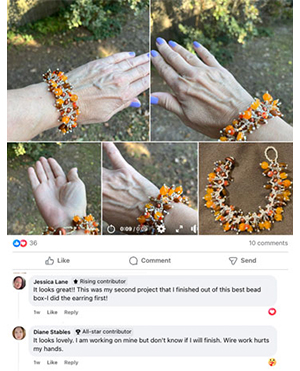- Jewelry-Making Supplies ▾
Design Jewelry with Confidence!
Seed Beads
Thread, Wire, & Stringing Materials
Athenacast Findings & Components
Everything Else
- Kits & Collections ▾
Assemble Your World
Kits & Collections
- Subscriptions ▾
Want monthly Beading Happiness?
Subscriptions
- Learn to Make ▾
Want to learn more?
- Discounts & Deals ▾
Explore Today's Promotions!
- Jewelry-Making Supplies
- Kits & Collections
- Subscriptions
- Learn to Make
- Discounts & Deals
-
Seed Beads
Thread, Wire, & Stringing Materials
Findings & Components
Everything Else
-
Kits & Collections
-
Subscriptions
- Home
- How to Make Jewelry
- Better Beader Episodes
- How to Identify Flat Beadweaving …
How to Identify Flat Beadweaving Stitches

Watch the Video Tutorial
Watch the Video Tutorial
Need Any Extra Materials?
Need Any Extra Materials?
Need Any Extra Materials?
Need Any Extra Materials?
Episode Transcript
Episode Transcript
Introduction
In Better Beader Episode 12, Allie and Katelyn dive into the world of flat beadweaving stitches, sharing their expert tips and techniques for identifying and distinguishing between different stitch patterns. Whether you're a beginner or an experienced beader, understanding the unique characteristics of each stitch can help you choose the perfect technique for your next project and troubleshoot any challenges along the way.
In this article, we'll break down the key insights from the episode and provide a handy guide to help you confidently identify flat beadweaving stitches in your own beading adventures.
The Importance of Stitch Identification
As Allie and Katelyn emphasize, being able to identify different flat beadweaving stitches is a valuable skill for any beader. Here are a few reasons why:
- It allows you to follow patterns and tutorials more easily, as you'll understand the terminology and techniques used.
- You can troubleshoot mistakes or issues in your beadwork by recognizing where you may have deviated from the intended stitch pattern.
- Identifying stitches helps you choose the best technique for a specific project based on factors like drape, stability, and design.
- You can recreate a stitch you admire in someone else's work or adapt a pattern to suit your preferences.
Common Flat Beadweaving Stitches
The episode covers several of the most popular flat beadweaving stitches, including:
- Peyote stitch
- Brick stitch
- Herringbone stitch
- Square stitch
- Right-angle weave (RAW)
Allie and Katelyn break down the defining features and characteristics of each stitch, offering visual cues and tips to help you distinguish between them.
Tips for Identifying Stitches
Throughout the episode, the hosts share their go-to strategies for identifying flat beadweaving stitches. Some key tips include:
- Look at the thread path and how the beads are connected to each other.
- Examine the shape and orientation of the beads in the pattern (e.g., stacked, offset, angled).
- Consider the overall texture and appearance of the beadwork (e.g., smooth, bumpy, ridged).
- Refer to stitch guides, diagrams, or samples to compare and confirm your identification.
Stitch Variations and Combinations
Allie and Katelyn also touch on the many variations and combinations of flat beadweaving stitches, such as:
- Even-count and odd-count peyote
- Circular and tubular brick stitch
- Flat and circular herringbone
- Combining multiple stitches in one project
They encourage beaders to experiment with different stitch variations and combinations to create unique designs and textures.
Conclusion
By the end of Better Beader Episode 12, you'll have a solid foundation for identifying and understanding the most common flat beadweaving stitches. Armed with this knowledge, you can approach your beading projects with greater confidence and creativity.
Remember to practice identifying stitches in your own work and in others' designs to reinforce your skills. Don't hesitate to refer back to the episode or this guide as needed, and feel free to ask questions or share your own stitch identification tips in the comments below!
Join Our Growing Community
Join Our Growing Community




Our Testimonials
Our Testimonials
- 55880 (83.8%)
- 4800 (11.4%)
- 3287 (4.1%)
- 228 (0.4%)
- 124 (0.3%)
- Favorite Reviews
- Highest to Lowest
- Newest to Oldest
- All Ratings
- 5 ★ Reviews
- 4 ★ Reviews
- 3 ★ Reviews
- 2 ★ Reviews
- 1 ★ Reviews
Loading...
Only Visible on Admin Mode
Item Description
Designer's Material List
Project Steps
Square Stitch: Similar to Ladder Stitch but focuses on adding one bead at a time for a square appearance.
Peyote Stitch: Add beads in an offset manner to create a brick wall effect, useful for creating textured patterns.
Netting Stitch: Use seed beads to create a flexible netting pattern, ideal for covering objects or adding texture.
Herringbone Stitch: Add two beads at a time, creating a distinctive V-shaped pattern for rows that offer a unique texture.
Right Angle Weave (RAW): Form boxes or squares by threading beads in a figure-eight pattern, allowing for versatile designs.
Highest Quality
Products
100% Money
Back Guarantee
Fast
Shipping
Best Teaching &
Customer Service
You'll want these emails...
Get Free Projects & Inspiration
Get Free Projects & Inspiration
- Bullet 1
- Bullet 2
- Bullet 3
Copyright © PotomacBeads









